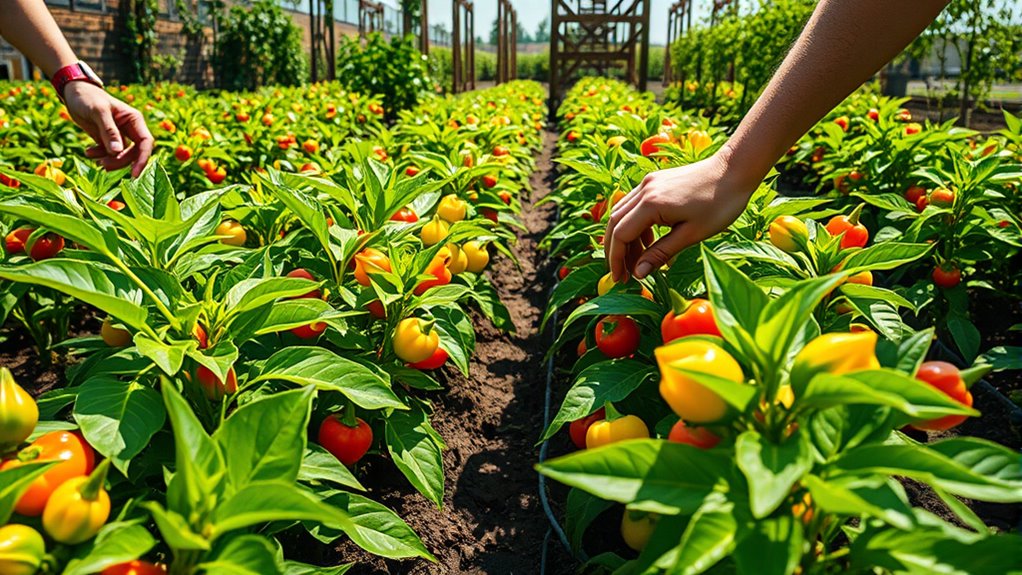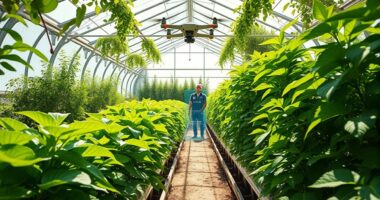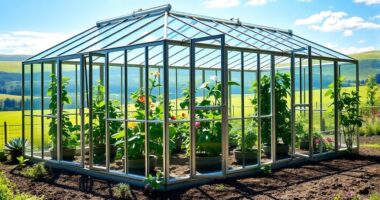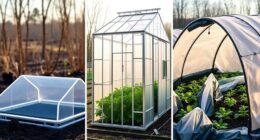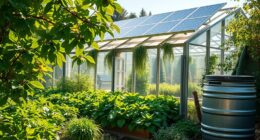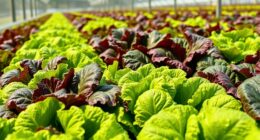To guarantee a bountiful pepper harvest, I’ve got six essential tips that work wonders. First, choose the right varieties suited to your taste and climate. Give them plenty of sunlight, ideally 6-8 hours a day. Water consistently, aiming for 1-2 inches a week, and don’t forget to mulch. Fertilize during growth stages with a balanced mix. Finally, practice natural pest control to keep your plants healthy. Stick around, and I’ll share more insights to boost your gardening success!
Key Takeaways
- Choose pepper varieties based on personal heat preferences and local climate conditions for optimal growth and culinary use.
- Ensure chilies receive at least 6 to 8 hours of direct sunlight daily in well-drained, nutrient-rich soil.
- Water peppers 1 to 2 inches per week, adjusting for rainfall, and use mulch to retain soil moisture.
- Fertilize with a balanced N-P-K ratio of around 5-10-10 and incorporate organic matter like compost for improved soil fertility.
- Implement natural pest control methods and practice consistent watering for healthier plants and increased yields.
Growing Chilies – A Beginners Guide to Growing Chilies at Home
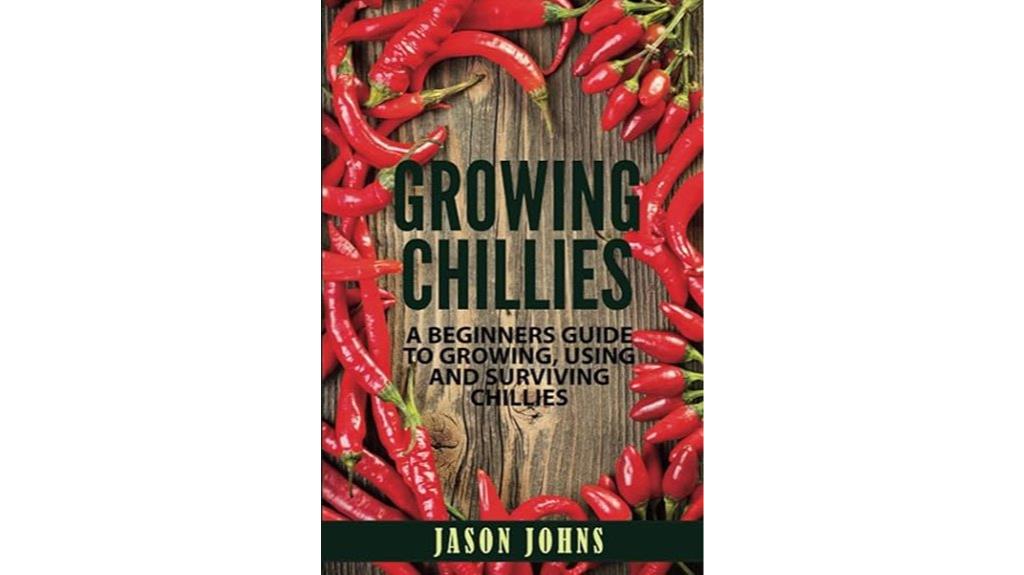
If you’re a beginner looking to spice up your home gardening, “Best Pepper Cultivation Tips” is the perfect guide for you. Growing chilies can be an exciting adventure! Start by choosing your favorite varieties, like jalapeños or habaneros, and make sure you provide them with a warm, sunny spot. Understanding Scoville heat units (SHU) helps you pick the right heat level for your dishes. I’ve found that watering consistently and using well-drained soil makes a huge difference. Plus, you’ll love experimenting with cooking recipes and salsas that showcase your homegrown chilies. Happy gardening!
Best For: Beginners looking to start growing chilies at home and enhance their cooking with fresh ingredients.
Pros:
- Comprehensive tips on growing a variety of chili peppers tailored for beginners.
- Clear information on ideal growing conditions and Scoville heat units to help choose the right chili for your taste.
- Includes cooking recipes and salsa ideas to make the most of your homegrown chilies.
Cons:
- Some users reported missing pages, indicating possible printing issues with the guide.
- Limited advanced techniques may not cater to experienced gardeners looking for in-depth information.
- May require additional resources for best results in specific growing conditions or climates.
The Preservers Handbook: Your Essential Guide to Canning and Preserving
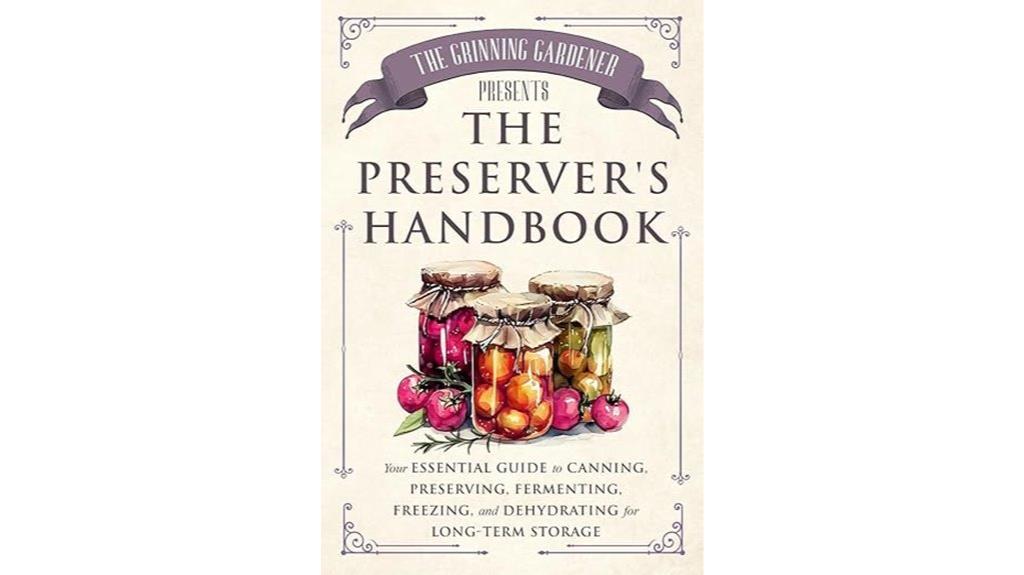
The Preservers Handbook is a must-have for anyone looking to plunge into the world of canning and food preservation, whether you’re a curious beginner or a seasoned homesteader. This thorough guide covers everything from canning to dehydrating, offering crystal-clear, step-by-step instructions that prioritize safety. I love the versatile recipes for fermented veggies and dehydrated snacks, which help reduce waste and save money. The troubleshooting section feels like having a mentor by your side. With personal testimonials highlighting successful canning experiences, it’s clear this handbook is an invaluable resource for anyone enthusiastic to embrace self-sufficiency and enjoy a bountiful harvest year-round.
Best For: Individuals seeking to learn about food preservation techniques, from beginners to experienced homesteaders.
Pros:
- Comprehensive guide covering various preservation methods, including canning, dehydrating, and fermenting.
- Clear instructions that prioritize food safety, making it accessible for novices.
- Includes practical tips for bulk buying and meal-in-a-jar ideas, promoting cost savings and reducing waste.
Cons:
- Not primarily a recipe book; focuses more on techniques than providing a wide variety of recipes.
- Limited coverage on advanced preservation methods, which may not satisfy experienced preservers looking for more complexity.
- Some users may find the emphasis on safety details overwhelming instead of helpful.
Ultimate Backyard Homesteading Guide for Beginners

Looking to immerse yourself in the world of homesteading? The Ultimate Backyard Homesteading Guide for Beginners is your go-to resource. It makes sustainable living achievable, even if you’re short on space. You’ll find tips on balcony gardening, raising chickens, and composting—all designed for busy families seeking fresh food. With step-by-step instructions for canning, pickling, and even making yogurt, it caters to both novices and seasoned gardeners. I love how it emphasizes natural pest control and DIY projects, making homesteading fun for everyone. This guide truly inspires me to embrace a self-sufficient lifestyle right in my backyard!
Best For: Beginners and busy families looking to engage in sustainable living and self-sufficiency in small spaces.
Pros:
- Provides practical tips for maximizing small spaces and budget-friendly gardening.
- Offers step-by-step instructions for various food preservation methods, making it accessible for novices.
- Emphasizes natural pest control and fun DIY projects, making homesteading enjoyable for families.
Cons:
- Some readers desire more illustrations, particularly for step-by-step processes.
- Limited advanced techniques may not fully satisfy experienced gardeners.
- May not cover some niche topics in-depth, focusing primarily on beginner-friendly content.
TKE Farms & Gardens Sweet Banana Pepper Seeds for Planting
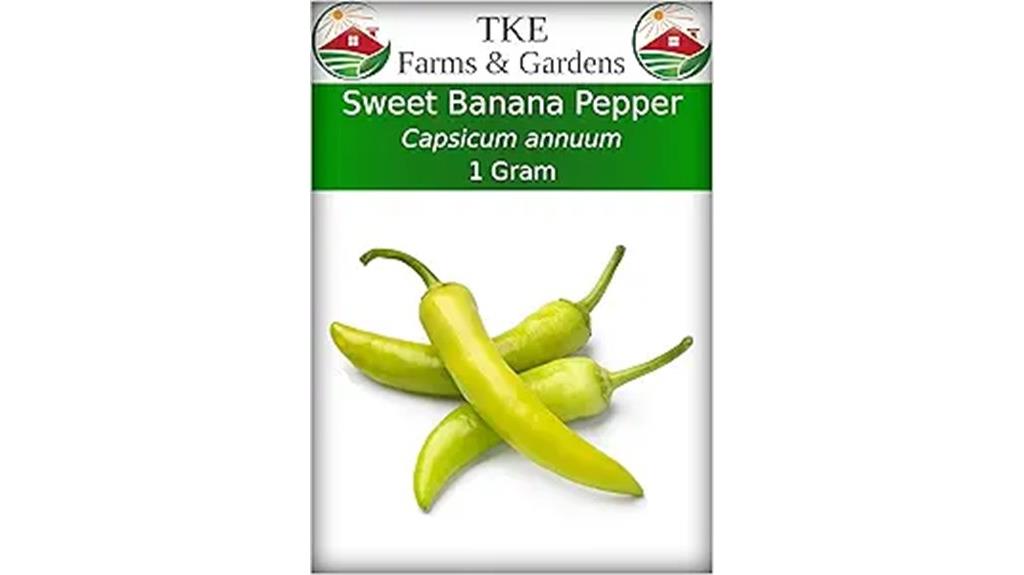
Gardeners seeking an easy-to-grow pepper variety will find TKE Farms & Gardens Sweet Banana Pepper Seeds ideal for their planting needs. Each 1-gram packet contains at least 140 heirloom, non-GMO seeds with high germination rates. These seeds produce vibrant, slender, banana-shaped peppers that mature from pale yellow to deep red or orange. I love their sweet taste and crisp texture, perfect for salads, sandwiches, or even pickling. They thrive in full sun and well-draining soil, making them suitable for all skill levels. Just remember to water regularly and fertilize occasionally for a bountiful harvest!
Best For: Home gardeners of all skill levels looking for a sweet and easy-to-grow pepper variety.
Pros:
- High germination rates ensure a successful planting experience.
- Versatile culinary uses, great for salads, sandwiches, and pickling.
- Thrives in full sun and requires minimal care, making it beginner-friendly.
Cons:
- Might require regular watering and occasional fertilization, which some may find demanding.
- Limited to one pepper variety, may not appeal to those wanting diverse options.
- Growth may be affected by poor soil drainage, necessitating specific soil conditions.
Essential Guide to Soil Science for a Flourishing Garden
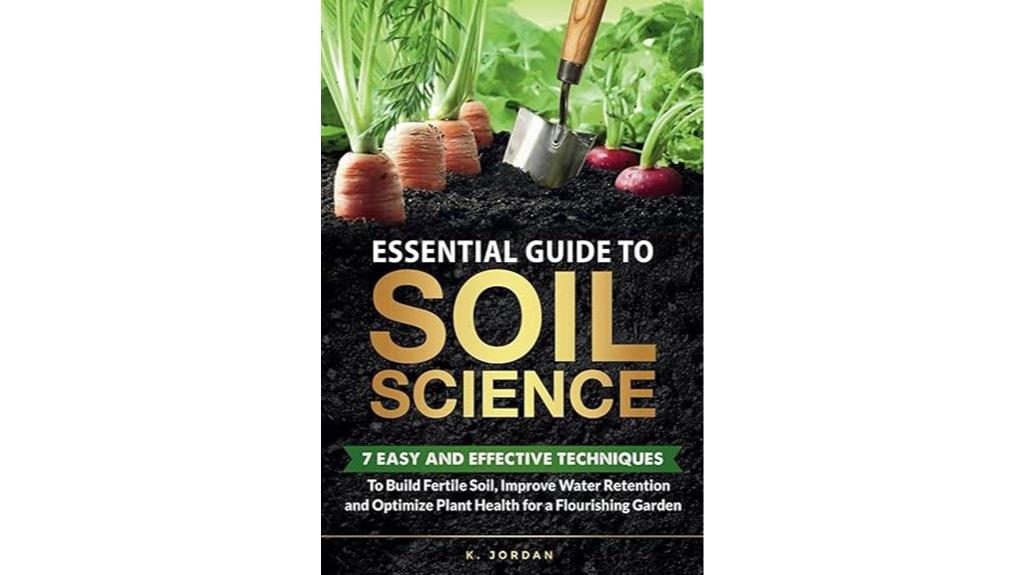
Soil plays a pivotal role in cultivating thriving pepper plants, making “Best Pepper Cultivation Tips” an essential resource for anyone wanting to enhance their gardening skills. I’ve found that understanding soil types and their impact on growth is vital. Creating fertile soil involves composting, balancing nutrients, and improving water retention. Seasonal practices, like winter preparation and spring planting, keep soil healthy year-round. Whether you’re a novice or seasoned gardener, this guide offers hands-on techniques and insights into soil microbiomes. While some sections could use more depth, it remains a valuable tool for boosting your garden’s productivity.
Best For: Gardeners of all skill levels looking to improve their soil health and enhance plant growth.
Pros:
- Comprehensive Techniques: Offers practical methods for building fertile soil and improving water retention.
- Seasonal Guidance: Provides year-round instructions for maintaining soil health through seasonal practices.
- Engaging Content: Includes straightforward explanations and insights into soil microbiomes that cater to various gardening experiences.
Cons:
- Lack of Depth: Some sections may be overly simplified, leaving readers wanting more detailed information.
- Repetitive Content: A few readers have noted repetition in certain areas, which could detract from the overall engagement.
- Limited Advanced Techniques: Experienced gardeners may find the information basic and seek more advanced soil management strategies.
Permaculture Gardening for Beginners: Grow Your Own Organic Food
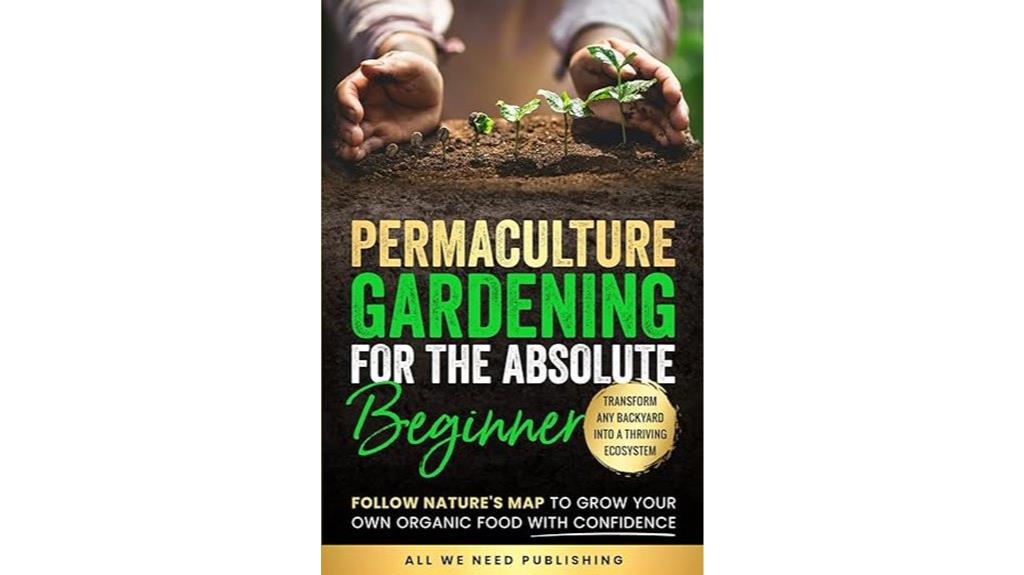
For anyone enthusiastic to plunge into the world of organic food cultivation, “Best Pepper Cultivation Tips” offers invaluable insights tailored specifically for beginners. I’ve found “Permaculture Gardening for the Absolute Beginner” to be a fantastic resource. It breaks down permaculture principles in an approachable way, making complex ideas easy to grasp. Each chapter wraps up key concepts, which I appreciate. The practical advice on planning, soil building, and even container gardening helps me get started right away. Plus, its emphasis on sustainability encourages me to grow food in my urban space. It’s a must-have reference for ongoing gardening adventures!
Best For: Beginners looking to understand permaculture principles and start their own sustainable gardens.
Pros:
- Provides a comprehensive introduction to permaculture with clear definitions and practical applications.
- Engaging writing style makes complex topics easy to understand and enjoyable to read.
- Serves as an ongoing reference resource with practical advice for gardeners of all experience levels.
Cons:
- At over 700 pages, it may feel overwhelming for some beginners to navigate through.
- Focus on sustainability might not resonate with those looking for more traditional gardening methods.
- Limited advanced topics may not satisfy highly experienced gardeners seeking in-depth strategies.
Factors to Consider When Choosing Pepper Cultivation
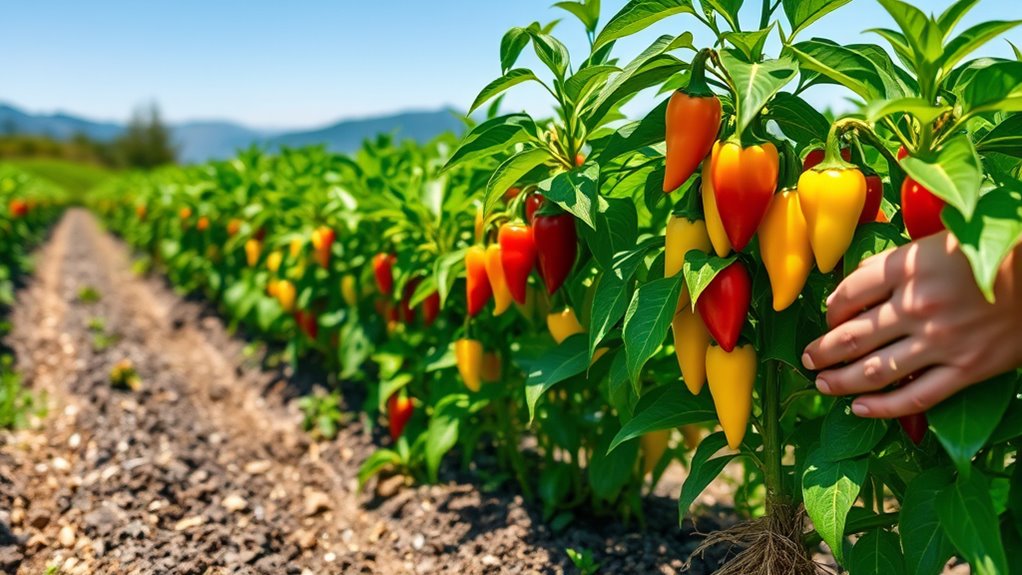
When I’m choosing the right peppers to grow, I consider several key factors. The variety of pepper, soil type, sunlight needs, watering frequency, and fertilization all play a significant role in my success. Let’s explore these points to make sure your pepper cultivation thrives!
Pepper Variety Selection
Choosing the right pepper variety is essential for a successful harvest. First, consider the Scoville heat units (SHU) to find peppers that match your heat preference—from mild bell peppers to fiery habaneros. Next, select varieties suited to your climate; some thrive in cooler conditions while others bask in the sun. Think about how you’ll use the peppers in your cooking; sweet banana peppers are perfect for salads, while others shine in salsas. Additionally, research the maturity and harvest time of different types, as this affects your planting schedule. Finally, I recommend looking for heirloom or non-GMO seeds to guarantee you get high-quality plants with unique flavors that hybrid varieties often lack. Happy planting!
Soil Type Requirements
After selecting the right pepper variety, the next step involves understanding the soil type requirements for ideal growth. Peppers thrive in well-draining soil rich in organic matter, which retains moisture and provides essential nutrients. I’ve found that an ideal soil pH ranges from 6.0 to 6.8, maximizing nutrient availability and promoting healthy plants. Sandy loam soils are particularly favorable since they warm quickly in spring and support robust root development. Regular soil testing helps me gauge nutrient levels and decide on necessary amendments. Before planting, I always incorporate compost or aged manure to enhance fertility and improve soil structure, ensuring a bountiful pepper harvest. With the right soil, your peppers will flourish!
Sunlight Exposure Needs
How can you assure your peppers get the sunlight they need for ideal growth? First, I make certain they get at least 6 to 8 hours of direct sunlight each day. Peppers thrive in full sun, and without enough light, I’ve seen plants become leggy and struggle to set fruit. Additionally, the sunlight affects the heat levels of the peppers; those grown in full sun often have higher Scoville heat unit ratings. When selecting a planting site, I make sure it’s free from shading by trees or buildings. However, I also keep in mind that young plants may benefit from some partial shade during extreme heat to prevent stress and sunburn. Balancing these factors is essential for a bountiful harvest.
Watering Frequency Guidelines
When it comes to watering peppers, understanding their needs is key to successful cultivation. Typically, peppers require about 1 to 2 inches of water per week, but I adjust this based on rainfall and temperature. I always make sure to water deeply and thoroughly, allowing moisture to reach the root zone for ideal growth. It’s essential to avoid overwatering, as soggy soil can lead to root rot and other diseases. During those hot, dry spells, I increase watering frequency, ideally in the early morning to minimize evaporation and prevent fungal issues. I also find that mulching around my pepper plants helps retain soil moisture and reduces the need for frequent watering, creating a healthier environment for my peppers.
Fertilization Recommendations
Understanding the right fertilization strategy is essential for thriving pepper plants. I’ve found that a balanced fertilizer with an N-P-K ratio of around 5-10-10 works wonders, promoting healthy root development and fruiting without excessive leaf growth. When I apply a slow-release fertilizer at planting, it provides consistent nutrients throughout the season, enhancing plant health and yield. Regular soil testing helps me determine specific nutrient needs, as peppers prefer slightly acidic soil with a pH of 6.0 to 6.8. I also incorporate organic matter like compost or well-rotted manure to improve soil fertility. Remember, adjust fertilization based on growth stages—higher nitrogen during early growth and more phosphorus and potassium as they flower and set fruit.
Pest Control Methods
After ensuring your peppers receive the right nutrients, protecting them from pests becomes a top priority. I’ve found that Integrated Pest Management (IPM) is a game changer. By combining biological, cultural, and mechanical methods, I can minimize pest populations while using fewer chemicals. I love introducing natural predators like ladybugs and lacewings to control aphids without pesticides. Additionally, crop rotation and companion planting help disrupt pest life cycles. Regularly monitoring my plants allows for early detection, so I can intervene before any serious damage occurs. When needed, I opt for organic solutions like neem oil or insecticidal soap, which are safe for beneficial insects and the environment. These methods keep my pepper plants healthy and thriving!
Harvesting Timing Considerations
How do you know the right time to harvest your peppers? It really depends on the variety. For sweet peppers, I wait until they’re fully mature and have reached their final color. Hot peppers, on the other hand, can be picked earlier if I want a spicier kick. Typically, peppers take about 70 to 90 days from planting to harvest, so I keep a close eye on their growth as that time approaches. Harvesting at the right moment not only boosts flavor but also increases their nutritional value. Plus, I make sure to harvest regularly to encourage new fruit production. When I cut peppers, I use a sharp knife or scissors to avoid damaging the plant, keeping it healthy for future harvests.
Climate Adaptability Factors
When choosing the right conditions for pepper cultivation, it’s vital to evaluate the climate adaptability of different varieties. Peppers thrive best in warm climates, ideally between 70°F and 85°F during the day, with nighttime temperatures above 55°F. I’ve found that consistent sunlight is important; they need at least six to eight hours of full sun daily to produce a bountiful harvest. Soil temperature is another significant factor, as peppers prefer it between 65°F and 75°F for ideal germination. Additionally, humidity levels should be kept between 40% and 70%; too much can lead to fungal issues, while too little stresses the plants. Finally, remember that different pepper varieties have varying heat and cold tolerances, so choose wisely for your region.
Frequently Asked Questions
What Pests Commonly Affect Pepper Plants and How Can I Manage Them?
I’ve faced various pests on my pepper plants, but the most common ones are aphids, spider mites, and whiteflies. To manage them, I regularly inspect my plants and remove any infested leaves. I also use neem oil or insecticidal soap as natural treatments. Introducing beneficial insects like ladybugs has helped too. Keeping my garden clean and healthy makes a big difference in preventing these pesky invaders from ruining my pepper harvest.
How Do I Determine the Right Time to Harvest My Peppers?
Harvesting peppers feels like unwrapping a gift from my garden. I usually wait until they reach their full color, whether that’s green, red, or yellow. I check the texture, too; they should feel firm, not soft. I also give them a gentle twist to see if they come off easily. If they do, I know it’s time! Trusting my instincts and keeping an eye on them helps me find that perfect moment.
Can I Grow Peppers Indoors Successfully?
Absolutely, I’ve grown peppers indoors successfully! It’s all about providing the right conditions. I make sure to use bright, direct light, ideally with grow lights if natural sunlight’s limited. I keep the temperature warm and maintain consistent humidity. Using good potting soil helps too. I’ve found that smaller pepper varieties work best indoors, and with a little care, I’ve enjoyed fresh peppers year-round right from my kitchen!
What Are the Best Companion Plants for Peppers?
When I think about the best companion plants for peppers, I find that planting basil nearby really helps. It not only enhances the flavor of my peppers, but it also repels pests. Marigolds are another favorite of mine; they attract beneficial insects that keep harmful ones at bay. I’ve also had success with planting onions, as they deter aphids. Overall, choosing the right companions can make a big difference in my garden!
How Can I Save Seeds From My Harvested Peppers?
I never imagined saving seeds could feel so rewarding. After harvesting my vibrant peppers, I carefully cut them open, revealing the tiny treasures inside. I scoop out the seeds, letting them dry on a paper towel for a few days. It’s thrilling to think I can grow my own plants next season. Once they’re fully dry, I store them in a labeled envelope, knowing I’ve secured a piece of my garden’s future.
Conclusion
To sum up, by applying these six pepper cultivation tips, I’ve seen my garden thrive with vibrant, flavorful peppers. Understanding soil quality, proper watering, and pest management has transformed my harvests. Visualizing my progress through photos helps me appreciate the journey from seed to table. Remember, every gardener’s experience varies, so don’t hesitate to experiment. Embrace the process, and you’ll soon enjoy a bountiful harvest that adds spice to your meals and joy to your gardening adventures!
